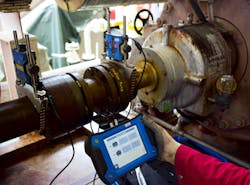In the engineering world, one needs to have a good, close working relationship with others so that either you or your staff don’t produce installation problems through un-professional or poor sensor mountings.
Large companies normally have a list of preferred vendors; this is followed by typical installation guidelines. These, along with the required descriptive text, contain photos that clearly show the desired mounting and should be used in all applications covered.
Any new application should be driven by discussions with all interested parties. Then everyone is on the same page, and new installation guidelines can be added to the document.
Mounting methods for position sensors play a crucial role in ensuring accurate and reliable measurement in industrial applications. Four common mounting methods for position sensors are stud mounting, adhesives, magnets and probe tips.
1. Stud mounting. In terms of guaranteed continued operation and accuracy, stud mounting, if it is possible, is the best option, in my experience.
Stud mounting involves securing the position sensor to a surface using threaded studs and nuts. The sensor typically has threaded holes or a threaded body for this purpose. This method has significant advantages. It provides a secure and stable attachment. This allows for precise adjustment and alignment. The method is suitable for all applications where a rigid and fixed mounting is required.
2. Adhesives. While there may be incredibly good adhesives on the market, one can never be 100% sure that the sensor does not come loose due to temperature deviations, moisture ingress or mainly through vibration. Adhesive mounting involves attaching the position sensor to a surface using adhesives or bonding agents. The sensor is directly bonded to the target surface. It does offer certain advantages; it offers flexibility in mounting on irregular or non-flat surfaces. It can also provide vibration dampening in certain applications, as well as eliminating the need for drilling holes in the target surface.
3. Magnets. Magnetic mounting of sensors is gaining in popularity, particularly in the process of taking readings such as vibration. The target has a marked position, and every measurement is then guaranteed to have the same measurement environment. Magnetic mounting utilizes magnets to attach the position sensor to a ferrous surface. The sensor typically has a magnetic base or is equipped with magnets for easy installation. It too has advantages, such as allowing for quick and non-destructive mounting. In addition, it facilitates easy repositioning and removal. It is ideal for temporary installations or applications with frequent adjustments.
4. Probe tips. The fourth mounting option for sensors employs the use of using a probe or stylus to physically contact the surface being measured. This method is common in applications where direct physical contact is necessary, such as in tactile or touch probes. It has advantages. For instance, it is suitable for applications requiring direct contact for measurement. It also offers high precision in certain applications. Finally, it finds use in harsh environments where non-contact methods may not be effective.
About the Author

Charles Palmer
Charles Palmer is a process control specialist and lecturer at Charles Palmer Consulting (CPC). Contact him at [email protected].

Leaders relevant to this article:
